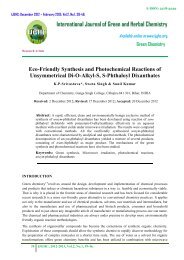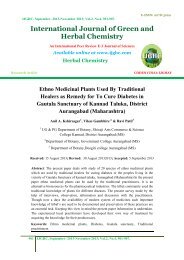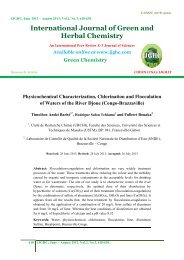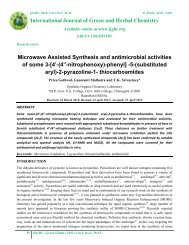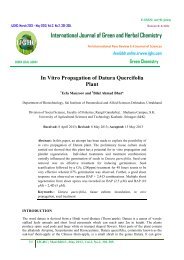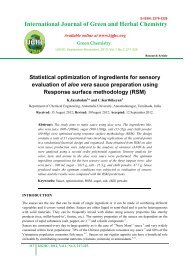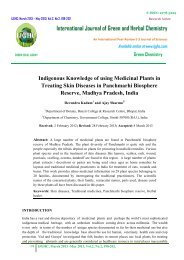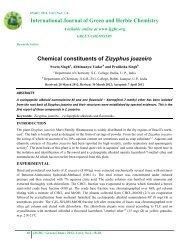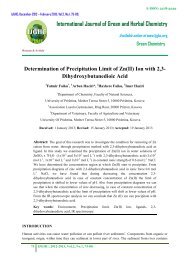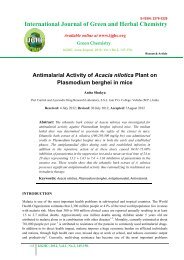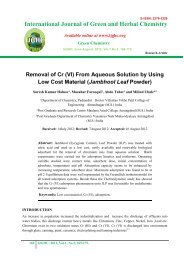Pharmacognostic and scientific evaluation of the plant- Tulsi - IJGHC
Pharmacognostic and scientific evaluation of the plant- Tulsi - IJGHC
Pharmacognostic and scientific evaluation of the plant- Tulsi - IJGHC
Create successful ePaper yourself
Turn your PDF publications into a flip-book with our unique Google optimized e-Paper software.
Research Article<br />
<strong>IJGHC</strong>; 2012, Vol.1.No.1, 75-90. E- ISSN: 2278 – 3229<br />
International Journal <strong>of</strong> Green <strong>and</strong> Herbal Chemistry<br />
Available online at www.ijghc.org<br />
HERBAL CHEMISTRY<br />
<strong>Pharmacognostic</strong> <strong>and</strong> <strong>scientific</strong> <strong>evaluation</strong> <strong>of</strong> <strong>the</strong><br />
<strong>plant</strong>- <strong>Tulsi</strong> (Ocimum sanctum)<br />
Vimal R. Joshi 1 , Charmi S.Mehta 2 , B.J Pattagiri 3 <strong>and</strong> P.K Prajapati 3<br />
1 Department <strong>of</strong> RS &BK, J.S Ayurved College, Nadiad (Gujarat) INDIA<br />
2 Department <strong>of</strong> Kayachikitsa, J.S Ayurved College, Nadiad(Gujarat) INDIA<br />
3 Department <strong>of</strong> RS &BK, IPGT &RA, Jamnagar (Gujarat) INDIA<br />
ABSTRACTS<br />
Received: 16 April 2012; Revised: 24 April 2012; Accepted: 29 April 2012<br />
The <strong>plant</strong> <strong>Tulsi</strong> is described vividly in Ayurved .Two types <strong>of</strong> <strong>Tulsi</strong> are described <strong>and</strong> <strong>the</strong>ir different<br />
Pharmacological actions <strong>and</strong> <strong>the</strong>rapeutic uses are also described in detail. <strong>Pharmacognostic</strong> study <strong>of</strong> a <strong>plant</strong><br />
not only helps to identify <strong>the</strong> <strong>plant</strong> among different species but also helps to differentiate <strong>the</strong> different types<br />
<strong>of</strong> <strong>the</strong> same <strong>plant</strong>. In <strong>the</strong> present study, review <strong>of</strong> <strong>the</strong> <strong>plant</strong> <strong>Tulsi</strong> was done from Ayurvedic texts <strong>and</strong><br />
macroscopic <strong>and</strong> microscopic sections were taken to identify <strong>the</strong> species.<br />
Keywords: <strong>Tulsi</strong>, pharmacognostic study<br />
INTRODUCTION<br />
<strong>Tulsi</strong> (Ocimum sanctum) is described in Ayurveda having many medicinal properties <strong>and</strong> a wide <strong>the</strong>rapeutic<br />
range. It is used specially in <strong>the</strong> management <strong>of</strong> kasa (cough), Shwasa (Ashtma), Jwara (fever) <strong>and</strong> pratishaya<br />
(common cold). In India, <strong>the</strong> herb <strong>Tulsi</strong> also called holy basil (sometimes spelled "Tulasi") has been widely<br />
known for its health promoting <strong>and</strong> medicinal value for thous<strong>and</strong>s <strong>of</strong> years. Commonly called sacred or holy basil,<br />
it is a principal herb <strong>of</strong> Ayurveda, <strong>the</strong> ancient traditional holistic health system <strong>of</strong> India. Holy basil is also known<br />
as "The Incomparable One", "The Mo<strong>the</strong>r Medicine <strong>of</strong> Nature", <strong>and</strong> "The Queen <strong>of</strong> Herbs".<br />
<strong>Tulsi</strong> is identified by botanists primarily as Ocimum sanctum (Rama <strong>and</strong> Krishna <strong>Tulsi</strong> varieties) or more recently<br />
Ocimum tenuiflorum, <strong>and</strong> Ocimum gratissimum (Vana <strong>Tulsi</strong> variety). Belonging to <strong>the</strong> Lamiaceae/Labiatae mint<br />
family, <strong>the</strong>se <strong>and</strong> o<strong>the</strong>r closely related species <strong>and</strong> varieties (e.g., Ocimum canum) are cousins <strong>of</strong> <strong>the</strong> familiar<br />
sweet basil cooking herb Ocimum basilicum. In parts <strong>of</strong> India, all <strong>of</strong> <strong>the</strong> basils are honoured as <strong>Tulsi</strong> 1 .<br />
The brief introduction <strong>of</strong> <strong>the</strong> <strong>plant</strong> <strong>Tulsi</strong> is as below:<br />
Scientific Classification 2<br />
Kingdom: Plantae<br />
(unranked) Angiosperms<br />
75 <strong>IJGHC</strong>; Herbal Chem.; 2012, Vol.1, No.1, 75-90
<strong>Pharmacognostic</strong>…<br />
Vimal R. Joshi et al.<br />
(unranked) Eudicots<br />
(unranked) Asterids<br />
Order: Lamiales<br />
Family: Lamiaceae<br />
Genus: Ocimum<br />
Species: O. tenuiflorum<br />
Binomial name: Ocimum tenuiflorum or Ocimum sanctum L.<br />
Part used : Panchang<br />
Vernacular names :<br />
Hindi : <strong>Tulsi</strong>, Tulas, Vrindha, Vir<strong>and</strong>ra<br />
Gujarati : <strong>Tulsi</strong>, <strong>Tulsi</strong><br />
English : Holy Basil, Sacred Basil, Mon'k's Basil, whitebasel,<br />
Mosquito <strong>plant</strong> <strong>of</strong> south Africa.<br />
Marathi : Tulasa, Surasa, Tulas<br />
Vargikarana or classification 3-4<br />
Swasahara Mahakashaya : According to Charaka<br />
Surasadi, Shirovirechana : According to Madanpal Nighantu<br />
Puspa varga : According to Bhavaprakash<br />
Rasa panchaka 5 - 6 :<br />
Rasa = Katu, Tikta & Kashaya<br />
Guna = Laghu, Ruksha, Tikshna<br />
Veerya = Ushna<br />
Vipaka = Katu<br />
Prabhava = Krimighna<br />
Doshaghnata <strong>and</strong> Karma: 7 Kapha vata Shamaka (Pacifies Kapha <strong>and</strong> vata doshas) & Jantughna (antiseptic)<br />
Property & guna karma 8 : Vedanahara ,Pachana ,Twagdoshahara, Anulomana , Sirovirecana , Krimighana ,<br />
Aksapanasanraka ,Hridya , Raktashodhaka ,Kasahara ,Ksayanasaka , Swasahara<br />
PHARMACOGNOSTIC STUDY 9-10 :<br />
Habit <strong>and</strong> habitat 11-12 : An erect herbaceous, much branched, s<strong>of</strong>tly hairy annual 30-75 cm, high found<br />
throughout India, ascending upto 1800 mt in Himalayas <strong>and</strong> Andaman Nicobar isl<strong>and</strong>s. It is considered sacred by<br />
Hindus. The <strong>plant</strong> is commonly cultivated in garden <strong>and</strong> also grown near temples. It is propagated by seeds. <strong>Tulsi</strong>,<br />
now - days is cultivated commercially for its volatile oil.<br />
76 <strong>IJGHC</strong>; Herbal Chem.; 2012, Vol.1, No.1, 75-90.
<strong>Pharmacognostic</strong>…<br />
Vimal R. Joshi et al.<br />
Material- Acharya Charaka has considered <strong>Tulsi</strong> under Shwashara Mahakashaya 13 . Hence, for <strong>the</strong> present study<br />
<strong>Tulsi</strong> leaf, steam <strong>and</strong> root was used.<br />
Collection <strong>of</strong> samples: <strong>Tulsi</strong> leaf, steam <strong>and</strong> root were collected from Jamnagar.<br />
Processing <strong>and</strong> Preservation: The collected Panchang was preserved in a solution <strong>of</strong> Formalin - Aceto Alcohol<br />
(FAA) Macroscopic <strong>and</strong> Microscopic Characters <strong>of</strong> <strong>the</strong> <strong>plant</strong> was studied systematically by taking transverse<br />
section. The <strong>plant</strong> was subjected for microscopic examination. Photomicrographs <strong>of</strong> all <strong>the</strong> section were also<br />
prepared. Diagnostic features were studied <strong>and</strong> presented here.<br />
Botanical description <strong>of</strong> <strong>the</strong> <strong>plant</strong> (Figure 1 <strong>and</strong> 2)<br />
Figure 1 Figure 2<br />
Root:Thin, wiry, branched, hairy, s<strong>of</strong>t, greenish brown externally & Pale blackish internally<br />
Stem: Erect, herbaceous, woody, branched, hairy, subquabrangular, externally greenish, internally cream<br />
coloured, fractured, fibrous, in barks & short in xylem, odour - faintly aromatic.<br />
Leaf:Leaves (Green type <strong>of</strong> O. sanctum), exstipulate, opposite, petiolate. Petiole 2.5 to 3.0 cm length, slender,<br />
thin, pubescent with narrow adaxial groove, lamina elliptical to ovoid, oblong 5-6 cm length, <strong>and</strong> 2.5 cm to 3 cm<br />
breadth, pubescent, margin entire, irregularly undulated or bluntly serrate, apex acute or obtuse, adaxial surface<br />
bright green, with prominent veins, venation pinnately reticulate with 5-6 alternate paits <strong>of</strong> lateral veins, gl<strong>and</strong>ular<br />
dots seen minutely on <strong>the</strong> abaxial side; odour - aromatic, & taste - pungent.<br />
Flower : Crimson coloured, small inclose whorls, bracts about 3 mm long <strong>and</strong> broad, pedicles longer than calyx<br />
& slender, pubescent calyx ovoid or campanulate, 3-4 mm bilipped, upper lip broadly obovate or sub orbicular,<br />
shortly apiculate, lower lip longer than upper having form nucronate teeth, lateral two short <strong>and</strong> central two<br />
largest, corolla 4 mm long, pubescent, odour, aromatic, taste pungent.<br />
Fruit : A group <strong>of</strong> 4 nut lets, each with one seed, enclosed in <strong>and</strong> enlarged, membranous, veined calyx, nut lets<br />
subglobose or broadly elliptic, slightly compressed, near smooth, pale brown or reddish with small black marking<br />
at <strong>the</strong> place <strong>of</strong> attachment to <strong>the</strong> thalamus, odour-aromatic, taste pungent.<br />
Seed:Rounded to oval brown mucilaginous when soaked in water; 0.1 cm long, slightly notched at <strong>the</strong> base, no<br />
odour, taste-pungent, slightly mucilaginous.<br />
77 <strong>IJGHC</strong>; Herbal Chem.; 2012, Vol.1, No.1, 75-90.
<strong>Pharmacognostic</strong>…<br />
Vimal R. Joshi et al.<br />
Microscopic characters: (Fig. No: 4, 5, 6)<br />
Fig.No.4<br />
Fig.No:5, 6<br />
TRANSVERSE SECTION<br />
Leaf: Midrib – Shows somewhat cordate outline, consisting <strong>of</strong> single layered epidermis composed <strong>of</strong> thin<br />
walled, oval cells having a number <strong>of</strong> covering <strong>and</strong> gl<strong>and</strong>ular trachomes covering trichomaes multicellular 1-7<br />
celled long, rarely slightly reflexes at tip, gl<strong>and</strong>ular trichomas short, sessile with small stalk <strong>and</strong> 2-8 celled ballon<br />
shaped head, measuring 22-27 in diameters, epidermis followed by 1 or 2 layers <strong>and</strong> 3 to 5 layers <strong>of</strong> thin walled,<br />
elongated, parenchyma cells towards upper <strong>and</strong> lower surfaces respectively, vascular bundles situated centrally.<br />
78 <strong>IJGHC</strong>; Herbal Chem.; 2012, Vol.1, No.1, 75-90.
<strong>Pharmacognostic</strong>…<br />
Vimal R. Joshi et al.<br />
Lamina: Leaf contains single layers <strong>of</strong> pallaside cells which indicate that leaves are <strong>of</strong> dorsiventral nature.<br />
Epidermis, trichomes are similary to those <strong>of</strong> midrib, both anomocytic <strong>and</strong> diacytic types <strong>of</strong> stomata present on<br />
both surface, slightly raised above <strong>the</strong> level <strong>of</strong> epidermis, pallaside single layered followed by 4-6 layers <strong>of</strong><br />
closely packed spongy parenchyma with chloroplast<br />
Stem: Shows somewhat cylindrical in shape. Upper surface having covering multicellular gl<strong>and</strong>ular trichomas,<br />
where covering multicellular trichomas have 5-12 cells. Single layered epidermis, 5 to 9 layers <strong>of</strong><br />
Parenchymateous cells in cortex region with fibre patches also available. Fibre made by sclerenchyma with its<br />
stain by phlorogucinal <strong>and</strong> HCl.<br />
Vascular bundles are available an periphery. Outerside phloem <strong>and</strong> inner side xylem, where xylem having vessels,<br />
tracheids which are stain by phlorogucinol <strong>and</strong> HCl. Centre portion is pith it’s contain parenchymatous cells.<br />
Root: One to five layers <strong>of</strong> small cells, some cells are stratified <strong>and</strong> unlignified. Nine to twelve rows <strong>of</strong><br />
tangentially elongated to isodiameteric parenchyma cells <strong>of</strong> cortex region contain some small groups to bigger<br />
groups <strong>of</strong> fibres. Vascular bundles contain phloem, vessels, tracheids <strong>and</strong> medullary rays. Medullary rays run<br />
radially from <strong>the</strong> center to <strong>the</strong> cortex through <strong>the</strong> phloem one to two cells in width.<br />
CHEMICAL CONSTITUENTS 14-19<br />
<strong>Tulsi</strong> leaves contain bright, yellow coloured & pleasant odour <strong>of</strong> volatile oil (0.1 to 0.9%). The oil content <strong>of</strong> <strong>the</strong><br />
drug varies depending upon <strong>the</strong> type, <strong>the</strong> place <strong>of</strong> cultivation & season <strong>of</strong> its collection. The oil is collected by<br />
steam distillation method from <strong>the</strong> leaves. It contains - Eugenol (70%) Carvacrol (3%), Eugenol methyl e<strong>the</strong>r<br />
(20%) Caryophyllin, linalool, Aneole, Chavicol, nerol, terpinin 4 - 01, decylaldehyde, r-selinene, α & β - pinenes,<br />
champhor sesequiterpenes.<br />
The <strong>plant</strong> is used as a pot herb; leaves are used as condiment in salads <strong>and</strong> o<strong>the</strong>r foods. It is also reputed to have<br />
medicinal properties. Besides <strong>the</strong> volatile oil, <strong>the</strong> <strong>plant</strong> is reported to contain alkaloids, glycosides, saponins <strong>and</strong><br />
tannins. The leaves contain ascorbic acid carotene, appreciable amount <strong>of</strong> Vitamin C, traces <strong>of</strong> maleic acid, citric<br />
<strong>and</strong> tartaric acid<br />
PHARMACOLOGICAL ACTION 20-21<br />
Leaf extract enhanced anti SRBC haemagglutination titre <strong>and</strong> IgE antibody titre, as measured by passive<br />
cutaneous anaphylaxis in rats; antigen- induced histamine release from peritoneal mast cells <strong>of</strong> sentisized rats in<br />
vitro was significantly inhibited by it, it also antigonised responses to various spasneogins by isolated guinea pig<br />
ileum. Thus, leaf extract modulates humoral immune response.Extract <strong>of</strong> leaves also showed highly significant<br />
clinical <strong>and</strong> biochemical clearance <strong>of</strong> viral hepatitis in 14 days <strong>of</strong> treatment.<br />
The oil is reported to posses antibacterial & iinsecticidal properties. It inhibits <strong>the</strong> invitro growth <strong>of</strong><br />
Mycobacterium tuberculosis <strong>and</strong> Micrococcus pyogens var. curves:in antitubercular activity, it has one-tenth <strong>the</strong><br />
potency <strong>of</strong> streptomycin <strong>and</strong> one –fourth that <strong>of</strong> isoniazid. It has marked insecticidal activity against mosquitoes,<br />
though it is not comparable to that <strong>of</strong> pyrethrum, <strong>the</strong> mosquito repellent action lasts for two hours. The oil is also<br />
active against Salmonella typhosa.<br />
The juice <strong>of</strong> leaves possess diaphoretics, antispasmodic, antiperiodic. Stimulating <strong>and</strong> expectorant properties: it is<br />
used to catarrh <strong>and</strong> bronchitis, applied to <strong>the</strong> skin in ringworm <strong>and</strong> o<strong>the</strong>r cutaneous disease <strong>and</strong> also in earache.<br />
An infusion <strong>of</strong> <strong>the</strong> leaves is used as a stomachic in gastric disorders <strong>of</strong> Children.<br />
PRECLINICAL STUDIES<br />
Antidiabetic: Ethanolic extract <strong>of</strong> O. sanctum L. significantly decreases <strong>the</strong> blood glucose, glycosylated<br />
hemoglobin <strong>and</strong> urea with a concomitant increase in glycogen, hemoglobin <strong>and</strong> protein in streptozotocin-induced<br />
79 <strong>IJGHC</strong>; Herbal Chem.; 2012, Vol.1, No.1, 75-90.
<strong>Pharmacognostic</strong>…<br />
Vimal R. Joshi et al.<br />
diabetic rats 22 . This extracts also resulted in an increase in insulin <strong>and</strong> peptide levels <strong>and</strong> glucose tolerance. The<br />
constituents <strong>of</strong> O. sanctum L. leaf extracts have stimulatory effects 23 on physiological pathways <strong>of</strong> insulin<br />
secretion, which may underlie its reported antidiabetic action. Grovel et al. suggested that treatment with O.<br />
sanctum L. extract for 30 days to normal rats fed with fructose for 30 days significantly lowered serum glucose<br />
level 24 in comparison with control group. However, O. sanctum L. extract has no significant effect on<br />
hyperinsulinemia. Ghosap et al. unravel <strong>the</strong> possible mechanism 25 <strong>of</strong> glucose-lowering activity <strong>of</strong> O. sanctum L.<br />
in male mice.<br />
The study suggested that O. sanctum L. decreases <strong>the</strong> serum concentration <strong>of</strong> both cortisol <strong>and</strong> glucose <strong>and</strong> also<br />
exhibited antiperoxidative effect. Therefore O. sanctum L. may potentially regulate corticosteroid- induced<br />
diabetic mellitus. In ano<strong>the</strong>r study <strong>the</strong> effect <strong>of</strong> O. sanctum L. on three important enzymes <strong>of</strong> carbohydrate<br />
metabolism [glucokinase (gk), hexokinase (hk) <strong>and</strong> phosph<strong>of</strong>ructokinase (PFK) along with glycogen content <strong>of</strong><br />
insulin-dependent (skeletal muscle <strong>and</strong> liver) <strong>and</strong> insulin-independent tissues (kidneys <strong>and</strong> brain) was studied by<br />
Vats et al 26 , in streptozotocin (STZ, 65 mg/kg)-induced model <strong>of</strong> diabetes for 30 days in rats. Administration <strong>of</strong> O.<br />
sanctum L. extracts 200 mg/kg for 30 days lead to decrease in plasma glucose levels by approximately 9.06 <strong>and</strong><br />
24.4% on 15th <strong>and</strong> 30th day. O. sanctum L. significantly decreased renal but not liver weight (expressed as % <strong>of</strong><br />
body weight) O. sanctum L. glycogen content in any tissue; also O. sanctum L. partially corrected <strong>the</strong> activity <strong>of</strong><br />
glucokinase (gk), hexokinase (hk) <strong>and</strong> phosph<strong>of</strong>ructokinase (PFK) distributed in <strong>the</strong> diabetic control.<br />
Tlsi (O. sanctum L.) leaf powder 27 was fed at <strong>the</strong> 1% level in normal <strong>and</strong> diabetic rats for a period <strong>of</strong> one month<br />
<strong>and</strong> <strong>the</strong> result indicated a significant reduction in fasting blood sugar urogenic acid, total amino acids level. This<br />
observation indicates <strong>the</strong> hypoglycemic effect <strong>of</strong> O. sanctum L. in diabetic rats.<br />
Chattopadyay also reported that oral administration <strong>of</strong> alcoholic extract <strong>of</strong> leaves <strong>of</strong> O. sanctum L. led to marked<br />
lowering <strong>of</strong> blood sugar 28 level in normal, glucose-fed hyperglycemic <strong>and</strong> streptozotocin-induced diabetic rats.<br />
Fur<strong>the</strong>rmore, <strong>the</strong> extract potentiates <strong>the</strong> action <strong>of</strong> exogenous insulin in normal rats. The activity <strong>of</strong> <strong>the</strong> extract was<br />
91.55 <strong>and</strong> 70.43% <strong>of</strong> that <strong>of</strong> Tolbutamide in normal <strong>and</strong> diabetic rats, respectively.<br />
Cardiac activity: Oral feeding <strong>of</strong> hydroalcoholic extract <strong>of</strong> O. sanctum L. (100 mg/kg) to male Wister rats<br />
subjected to chronic-resistant stress (6 h/day for 21 days) significantly prevented <strong>the</strong> chronic-resistant<br />
stress/induced rise in plasma cAMP level, myocardial superoxide dismutase <strong>and</strong> catalase activities 29 as well as <strong>the</strong><br />
light microscopic changes in <strong>the</strong> myocardium. Wister rats fed with fresh leaf homogenate <strong>of</strong> O. sanctum L. (50<br />
<strong>and</strong> 100 mg/kg body weight) daily 30 days inhibit isoproterenol-induced changes 30 in myocardial superoxide<br />
dismutase, glutathione peroxidase <strong>and</strong> reduced glutathione.<br />
In ano<strong>the</strong>r study effect <strong>of</strong> pre- <strong>and</strong> co-treatment <strong>of</strong> hydroalcoholic extract <strong>of</strong> O. sanctum L. at different doses (25,<br />
50, 75, 100, 200 <strong>and</strong> 400 mg/kg) was investigated against isoproterenol (ISO, 20 mg/kg, Sc) myocardial infarction<br />
31<br />
in rats. O. sanctum L. at <strong>the</strong> dose <strong>of</strong> 25, 50, 75 <strong>and</strong> 100 mg/kg significantly reduced glutathione (GSH),<br />
superoxide dismutase <strong>and</strong> LDH levels. In this study, it was observed that O. sanctum L. at <strong>the</strong> dose <strong>of</strong> 50 mg/kg<br />
was found to demonstrate maximum cardioprotective effect. The generation <strong>of</strong> drug-induced oxygen radicals in<br />
heart cells led to cardiac lipid 32 membrane peroxidation. Urosolic acid (UA) isolated from O. sanctum L. have<br />
been identified as a protector against Adriamycin (ADR)-induced lipid peroxidation. Protection with UA was 13<br />
<strong>and</strong> 17% in liver <strong>and</strong> heart microsomes, respectively. On combination with oleanolic acid (OA) isolated from<br />
Eugenia jumbolata , it increased to 69%.<br />
Wound healing activity: Shetty et al, 33 evaluated <strong>the</strong> wound healing effect <strong>of</strong> aqueous extract <strong>of</strong> O. sanctum L.<br />
in rats. Wound-breaking strength in incision wound model, epi<strong>the</strong>lization period <strong>and</strong> percent wound concentration<br />
in excision wound model were studied owing to increased per cent wound contraction. Ocimum sanctum L. may<br />
be useful in <strong>the</strong> management <strong>of</strong> abnormal healing such as keloids <strong>and</strong> hypertropic scars. Ethanolic extract <strong>of</strong><br />
leaves <strong>of</strong> O. sanctum L. was investigated for normal wound healing <strong>and</strong> dexamethasone-depressed healing 34 . The<br />
80 <strong>IJGHC</strong>; Herbal Chem.; 2012, Vol.1, No.1, 75-90.
<strong>Pharmacognostic</strong>…<br />
Vimal R. Joshi et al.<br />
extract significantly increased <strong>the</strong> wound breaking strength, wound epi<strong>the</strong>lializes fast <strong>and</strong> wound contraction was<br />
significantly increased along with increase in wet <strong>and</strong> dry granulation tissue weight <strong>and</strong> granulation tissue<br />
breaking strength. The extract also significantly decreases <strong>the</strong> anti-healing activities <strong>of</strong> dexamethasone in all<br />
wound healing models.<br />
Radio-protective effect: Radio-protective effect 35 <strong>of</strong> aqueous extract <strong>of</strong> O. sanctum L. (40 mg/kg, for 15 days) in<br />
mice exposed to high doses (3.7 MBq) <strong>of</strong> oral 131 iodine was investigated by studying <strong>the</strong> organ weights, lipid<br />
peroxidation <strong>and</strong> antioxidant defense enzyme in various target organs like liver, kidney, salivary gl<strong>and</strong>s <strong>and</strong><br />
stomach at 24 h after exposure. Pretreatment with O. sanctum L. in radioiodine-exposed group showed significant<br />
reduction in lipid peroxidation in both kidney <strong>and</strong> salivary gl<strong>and</strong>s. In liver, reduced glutathione (GSH) levels<br />
showed significant reduction after radiation exposure while pretreatment with O. sanctum L. exhibited less<br />
depletion in GSH level even after 131 iodine exposure. However, no such changes were observed in <strong>the</strong> stomach.<br />
The results indicate <strong>the</strong> possibility <strong>of</strong> using aqueous extract <strong>of</strong> O. sanctum L. for ameliorating 131 iodine induced<br />
damage to <strong>the</strong> salivary gl<strong>and</strong>. Two polysaccharides isolated from O. sanctum L. could prevent oxidative damage<br />
36 to liposomal lipids <strong>and</strong> plasmid DNA induced by various oxidants such as iron, AAPH <strong>and</strong> gamma radiation.<br />
Vrinda et al. reported that two water-soluble flavonoids, Orientin (Ot) <strong>and</strong> Vicenin (Vc), isolated from <strong>the</strong> leaves<br />
<strong>of</strong> O. sanctum L. provide significant protection against radiation, 37 lethality <strong>and</strong> chromosomal aberration in vivo.<br />
In order to select <strong>the</strong> most effective drug concentration, fresh whole blood was exposed to 4 Gy <strong>of</strong> cobalt-60<br />
gamma radiation with O. sanctum L. without a 30 min pretreatment with 6.25, 12.5, 15, 17.5 <strong>and</strong> 20 micron <strong>of</strong><br />
Ot/Vc in micronucleus test. Radiation significantly increased <strong>the</strong> micronucleus (MN) frequently. Pretreatment<br />
with ei<strong>the</strong>r Ot or Vc at all concentration-dependent manner, with optimum effect at 17.5 μm.<br />
The effect <strong>of</strong> aqueous extract (OE) <strong>of</strong> leaves <strong>of</strong> O. sanctum L. against radiation lethality 38 <strong>and</strong> chromosome<br />
damage was studied by radiation-induced lipid peroxidation in liver. Adult Swiss mice were injected with 10<br />
mg/kg <strong>of</strong> gamma radiation 30 min after last injection. Glutathione (GSH) <strong>and</strong> <strong>the</strong> antioxidant enzymes glutathione<br />
transferase (GST), reductase (GSRx), peroxidase (GSPx) <strong>and</strong> superoxide dismutase (SOD) as well as lipid<br />
peroxide (LPx) activity were estimated in <strong>the</strong> liver at 15 min, 30 min, 1, 2, 4 <strong>and</strong> 8 h post-treatment. Aqueous<br />
extract itself increased <strong>the</strong> GSH <strong>and</strong> enzymes significantly above normal level, whereas radiation significantly<br />
reduced all <strong>the</strong> values <strong>and</strong> significantly increased <strong>the</strong> lipid peroxidation rate, reaching a maximum value at 2 h<br />
after exposure (3.5 times <strong>of</strong> control). Aqueous extract significantly reduced <strong>the</strong> lipid peroxidation <strong>and</strong> accelerated<br />
recovery to normal levels. In a comparative study 39 <strong>of</strong> radioprotection by ocimum flavonoids <strong>and</strong> syn<strong>the</strong>tic<br />
aminothiol protectors in mouse showed Ocimum flavonoids as promising human radiation protectant. In this<br />
study, adult Swiss mice were injected intraperitoneally with 50 μg/kg body weight <strong>of</strong> Orientin (OT) or vicenin<br />
(Vc) 20 mg/kg body weight <strong>of</strong> 2-ercaptopropionyl glycine (MPG) 150 mg/kg body weight <strong>of</strong> WR2721 <strong>and</strong><br />
exposed to whole body irradiation <strong>of</strong> 2 Gy gamma radiation 30 min later. After 24 hours, chromosomal<br />
aberrations were studied in <strong>the</strong> bone marrow <strong>of</strong> <strong>the</strong> femur by routine metaphase preparation after colchicines<br />
treatment. Pretreatment with all <strong>the</strong> protective compounds resulted in a significant reduction in <strong>the</strong> percentage <strong>of</strong><br />
aberrant metaphases. Vicenin produced <strong>the</strong> maximum reduction in per cent aberrant cells while MPG was <strong>the</strong><br />
least effective; OT <strong>and</strong> WR-2721 showed an almost similar effect.<br />
Ganasoundari et al. 40 investigated <strong>the</strong> radio-protective effect <strong>of</strong> <strong>the</strong> leaf extract <strong>of</strong> O. sanctum L. (OE) in<br />
combination with WR-2721 (WR) on mouse bone marrow. Adult Swiss mice were injected intraperitoneally with<br />
OE (10 mg/kg for five consecutive days) alone or 100-400 mg/kg WR (Single dose) O. sanctum L. combination<br />
<strong>of</strong> <strong>the</strong> two <strong>and</strong> whole body was exposed to 4.5Gy gamma irradiation (RT). Metaphase plates were prepared from<br />
femur bone marrow on days 1, 2, 7 <strong>and</strong> 14 post-treatment <strong>and</strong> chromosomal aberrations were scored. Pretreatment<br />
with OE or WR individually resulted in a significant decrease in aberrant cells as well as different types <strong>of</strong><br />
aberrations. The combination <strong>of</strong> <strong>the</strong> two fur<strong>the</strong>r enhanced this effect; resulting in a two-fold increase in <strong>the</strong><br />
protection factors (PF = 6.68) compared to 400 mg/kg WR alone.<br />
81 <strong>IJGHC</strong>; Herbal Chem.; 2012, Vol.1, No.1, 75-90.
<strong>Pharmacognostic</strong>…<br />
Vimal R. Joshi et al.<br />
Genotoxicity: In vivo cytogenetic assay 41 in Allium cepa root tip cells has been carried out to detect <strong>the</strong><br />
modifying effect <strong>of</strong> O. sanctum L. aqueous leaf extract against chromium (Cr) <strong>and</strong> mercury (Hg)-induced<br />
genotoxicity. It was observed that <strong>the</strong> roots post-treated with <strong>the</strong> leaf extract showed highly significant recovery in<br />
mitotic index (MI) <strong>and</strong> chromosomal aberrations. When compared to pre-treated (Cr/Hg) samples, <strong>the</strong> lower<br />
doses <strong>of</strong> <strong>the</strong> leaf extract were found to be more effective than <strong>the</strong> higher doses. Immu-21, a poly-herbal<br />
formulation containing O. sanctum L. <strong>and</strong> o<strong>the</strong>r herbal extracts when given at 100 mg per kg daily over 7 days<br />
<strong>and</strong> 300 mg/kg daily over 14 days inhibited both cyclophosphamide (40 mg/kg i.p.)-induced classical <strong>and</strong> nonclassical<br />
chromosomal aberration 42 (40-60% <strong>of</strong> control). This also reduces <strong>the</strong> increase in micronuclei in <strong>the</strong> bone<br />
marrow erythrocytes <strong>of</strong> mice treated with cyclophosphamide.<br />
Antioxidant: The antioxidant capacity <strong>of</strong> 43 essential oils obtained by steam hydrodistillation from O. sanctum L.<br />
was evaluated using a high-performance liquid chromatography (HPLC) based hypoxanthine xanthine oxidase<br />
<strong>and</strong> OPPH assays. In hypoxanthine xanthine oxidase assay, strong antioxidant capacity was evident from O.<br />
sanctum L. (IC 50 = 0.46 μL/ml).<br />
In ano<strong>the</strong>r study <strong>the</strong> aqueous extract <strong>of</strong> O. sanctum L. significantly increases <strong>the</strong> activity <strong>of</strong> anti-oxidant 44.<br />
enzymes such as superoxide dismutase, catalase level in extract-treated group compared to control. Aqueous<br />
extract <strong>of</strong> O. sanctum L. inhibit <strong>the</strong> hypercholesterolemia-induced 45 erythrocyte lipid peroxidation activity in a<br />
dose-dependent manner in male albino rabbits. Oral feeding also provides significant leaver <strong>and</strong> aortic tissue<br />
protection from hypercholestrolemia-induced peroxidative damage. The effect <strong>of</strong> methanolic extract <strong>of</strong> O.<br />
sanctum L. leaves in cerebral reperfusion injury 46 as well as long-term hypoperfusion was studied by Yanpallewar<br />
et al. Osimum sanctum L. pretreatment (200 mg/kg/day for 7 days) prevented reperfusion-induced rise in lipid<br />
peroxidation <strong>and</strong> superoxide dismutase. Osimum sanctum L. pretreatment also stabilized <strong>the</strong> levels <strong>of</strong> tissue total<br />
sulfhydryl group during reperfusion.<br />
Hypolipidemic : Administration <strong>of</strong> O. sanctum L. seed oil (0.8 gm/kg body weight/day) for four weeks, in<br />
cholesterol-fed (100 mg/kg body weight/day) rabbits significantly decreases serum cholesterol, triacylglycerol<br />
<strong>and</strong> LDL + VLDL cholesterol as compared to untreated cholesterol-fed group suggesting <strong>the</strong> hypocholesterolemic<br />
activity <strong>of</strong> O. sanctum L. Fresh leaves <strong>of</strong> O. sanctum L. mixed OS 1 <strong>and</strong> 2 g in 100 gm <strong>of</strong> diet<br />
given for four weeks brought about significant changes in <strong>the</strong> lipid 47 <strong>of</strong> normal albino rabbits. This resulted in<br />
significant lowering in serum total cholesterol, triglyceride, phospholipids <strong>and</strong> LDL-cholesterol level <strong>and</strong><br />
significant increase in <strong>the</strong> HDL-cholesterol <strong>and</strong> total fecal sterol contents.<br />
Antimicrobial: Singh et a.l 48 in his study suggested that higher content <strong>of</strong> linoleic acid in O. sanctum L. fixed oil<br />
could contribute towards its antibacterial activity. The oil show good antibacterial activity against Staphylococcus<br />
aureus, Bacillus pumius <strong>and</strong> Pseudomonas aeruginosa, where S. aureus was <strong>the</strong> most sensitive organism. Geeta<br />
et al. 49 studied that <strong>the</strong> aqueous extract <strong>of</strong> O. sanctum L. (60 mg/kg) show wide zones <strong>of</strong> inhibition compared to<br />
alcoholic extract against Klebsiella, E. coli, Proteus, S. aureus <strong>and</strong> C<strong>and</strong>ida albicans when studied by agar<br />
diffusion method. Alcoholic extract showed wider zone for Vibrio cholerae.<br />
Effect on gene transcription: The genes that have direct role in ar<strong>the</strong>rogenesis include LDRL, LxRalpha,<br />
PPARs, CD-36 because <strong>the</strong>se genes control lipid metabolism, cytotoxin production <strong>and</strong> cellular activity within <strong>the</strong><br />
arterial wall. To know whe<strong>the</strong>r or not <strong>the</strong> polyphenols extracted from O. sanctum L. have any effect on <strong>the</strong><br />
transcription 50 <strong>of</strong> <strong>the</strong>se genes, Kaul et al. cultured human mononuclear cells in <strong>the</strong> presence <strong>of</strong> polyphenols<br />
extracted from O. sanctum L. Transcriptional expression <strong>of</strong> <strong>the</strong>se genes was measured by using RT-PCR <strong>and</strong><br />
SCION IMAGE analysis s<strong>of</strong>tware. These polyphenolic extracts were found to have <strong>the</strong> inherent capacity to<br />
inhibit <strong>the</strong> transcriptional expression <strong>of</strong> <strong>the</strong>se genes.<br />
Gastroprotective: The st<strong>and</strong>ardized methanolic extract <strong>of</strong> leaves <strong>of</strong> O. sanctum L. (OSE) given in doses <strong>of</strong> 50-<br />
200 mg/kg orally twice daily for five days showed dose-dependent ulcer protective effect against cold-restraint<br />
stress-induced gastric ulcers. Optimal effective dose (100 mg/kg) <strong>of</strong> OSE showed significant ulcer protection 51<br />
82 <strong>IJGHC</strong>; Herbal Chem.; 2012, Vol.1, No.1, 75-90.
<strong>Pharmacognostic</strong>…<br />
Vimal R. Joshi et al.<br />
against ethanol <strong>and</strong> pyloric ligation induced gastric ulcer but was ineffective against aspirin-induced ulcer. OSE<br />
(100 mg/kg) also inhibits <strong>the</strong> <strong>of</strong>fensive acid pepsin secretion <strong>and</strong> lipid peroxidation <strong>and</strong> increases <strong>the</strong> gastric<br />
defensive factors like mucin secretion, cellular mucus <strong>and</strong> lifespan <strong>of</strong> mucosal cells. Dharmani et al. evaluated <strong>the</strong><br />
anti-ulcerogenic activity 52 in cold-restraint (CRU), aspirin (ASP), alcohol (Al), pyloric ligation (PL) induced<br />
gastric ulcer models in rats, histamine-induced (HST) duodenal ulcer in guinea pigs <strong>and</strong> ulcer healing activity in<br />
acetic acid induced (AC) chronic ulcer model. Osimum sanctum L. at a dose <strong>of</strong> 100 mg/kg was found to be<br />
effective in CRU (65.07%), ASP (63.49%), Al (53.87%), PL (62.06%) <strong>and</strong> HST (61.76%) induced ulcer models<br />
<strong>and</strong> significantly reduced free, total acidity <strong>and</strong> peptic activity by 72.58, 58.63 <strong>and</strong> 57.6%, respectively, <strong>and</strong><br />
increased mucin secretion by 34.61% conclusively Osimum sanctum L. could act as a potent <strong>the</strong>rapeutic agent<br />
against peptic ulcer disease. The antiulcerogenic 53 property <strong>of</strong> O. sanctum L. was studied in pyloric-ligated <strong>and</strong><br />
aspirin-treated rats. The extract <strong>of</strong> reduced ulcer index, free <strong>and</strong> total acidity on acute <strong>and</strong> chronic administration<br />
seven days pretreatment increased <strong>the</strong> mucus secretion also. So it may be concluded that O. sanctum L. extract<br />
has anti-ulcerogenic property against experimental ulcers <strong>and</strong> it is due to its ability to reduce acid secretion <strong>and</strong><br />
increase mucus secretion.<br />
Immunomodulatory effect: Immuno<strong>the</strong>rapeutic potential 54 <strong>of</strong> aqueous extract <strong>of</strong> O. sanctum L. leaf in bovine<br />
sub-clinical mastitis (SCM) was investigated after intramammary infusion <strong>of</strong> aqueous extract. The results<br />
revealed that <strong>the</strong> aqueous extract <strong>of</strong> O. sanctum L. treatment reduced <strong>the</strong> total bacterial count <strong>and</strong> increased<br />
neutrophil <strong>and</strong> lymphocyte counts with enhanced phagocytic activity <strong>and</strong> phagocytic index. In ano<strong>the</strong>r study, <strong>the</strong><br />
immunomodulatory effect <strong>of</strong> O. sanctum L. seed oil (OSSO) was evaluated in both non-stressed <strong>and</strong> stressed<br />
animals. 55 Osimum sanctum L. seed oil (3 ml/kg, Ip )produced a significant increase in anti-sheep red blood cells<br />
(SRBC) antibody titer <strong>and</strong> a decrease in percentage histamine release from peritoneal mast cell <strong>of</strong> sensitized rats<br />
(humoral immune responses) <strong>and</strong> decrease in food pad thickness <strong>and</strong> percentage leucocyte migration inhibition<br />
(cell-mediated immune responses). Co-administration <strong>of</strong> diazepam (1 mg/kg, Sc), a benzodiazepine (BZD) with<br />
OSSO (1 mg/kg, IP) enhanced <strong>the</strong> effect <strong>of</strong> OSSO on resistant stress induced changes in both humoral <strong>and</strong> cellmediated<br />
immune responses. Fur<strong>the</strong>r, flumazenil (5 mg/kg, IP) a central BZD receptor antagonist inhibited <strong>the</strong><br />
immunomodulatory action <strong>of</strong> OSSO on resistant stress induced immune responsiveness. Thus, OSSO apparatus to<br />
modulate both humoral <strong>and</strong> cell-mediated immune responsiveness <strong>and</strong> <strong>the</strong>se immunomodulatory effects may be<br />
mediated by GABAnergic pathway. Godhwani et at. 56 investigated <strong>the</strong> immunoregulatory pr<strong>of</strong>ile <strong>of</strong> methanolic<br />
extract <strong>and</strong> an aqueous suspension <strong>of</strong> O. sanctum L. leaves to antigenic challenge <strong>of</strong> Salmonella typhosa <strong>and</strong><br />
sheep erythrocytes by quantifying agglutinating antibodies employing <strong>the</strong> Widal agglutination <strong>and</strong> sheep<br />
erythrocyte agglutination tests <strong>and</strong> E-rosette formation in albino rats. The data <strong>of</strong> <strong>the</strong> study indicate an<br />
immunostimulation <strong>of</strong> humoral immunogenic response as represented by an increase in antibody titer in both <strong>the</strong><br />
Widal <strong>and</strong> sheep erythrocyte agglutination tests as well as by cellular immunologic response represented by E-<br />
rosette formation <strong>and</strong> lymphocytosis.<br />
Sexually transmitted disease: Extract <strong>of</strong> O. sanctum L. caused inhibition <strong>of</strong> Neisseria gonorrhoeae clinical<br />
isolates 57 <strong>and</strong> WHO organization strains. The activity is comparable to penicillin <strong>and</strong> cipr<strong>of</strong>loxacin.<br />
Effect on central nervous system (CNS) : Different extracts <strong>of</strong> stem, leaf <strong>and</strong> stem callus (induced on slightly<br />
modified Murashige <strong>and</strong> Skoog's medium <strong>and</strong> supplemented with 2,4-dichlorophenonyacetic acid <strong>and</strong> kinetin)<br />
were tested for anticonvulsant activity 58 by maximal electroshock model using Phenytoin as st<strong>and</strong>ard. It was<br />
observed that ethanol <strong>and</strong> chlor<strong>of</strong>orm extractives <strong>of</strong> stem, leaf <strong>and</strong> stem calli were effective in preventing tonic<br />
convulsions induced by transcorneal electroshock. Ethanolic extract <strong>of</strong> leaves <strong>of</strong> O. sanctum L. prolonged <strong>the</strong><br />
time <strong>of</strong> lost reflex in mice due to pentobarbital, 59 decreased <strong>the</strong> recovery time <strong>and</strong> severity <strong>of</strong> electroshock <strong>and</strong><br />
pentylenetetrazole-induced convulsions <strong>and</strong> decreased apomorphine-induced fighting time <strong>and</strong> ambulation in<br />
'open field' studies. In <strong>the</strong> forced swimming behavioral despair model, <strong>the</strong> extract lowered immobility in a manner<br />
comparable to Imipramine. This action was blocked by haloperidol <strong>and</strong> sulpiride, indicating a possible action<br />
83 <strong>IJGHC</strong>; Herbal Chem.; 2012, Vol.1, No.1, 75-90.
<strong>Pharmacognostic</strong>…<br />
Vimal R. Joshi et al.<br />
involving dopaminergic neurons. In similar studies, <strong>the</strong>re was a synergistic action when <strong>the</strong> extract was combined<br />
with bromocriptine, a potent D2-receptor agonist. Nootropic agents are a new class <strong>of</strong> drugs used in situations<br />
where <strong>the</strong>re is organic disorder in learning abilities.<br />
Joshi <strong>and</strong> Parle 60 assessed <strong>the</strong> potential <strong>of</strong> O. sanctum L. extract as a nootropic <strong>and</strong> anti-amensic agent in mice.<br />
Aqueous extract <strong>of</strong> derived whole <strong>plant</strong> <strong>of</strong> O. sanctum L. ameliorated <strong>the</strong> amensic effect <strong>of</strong> scopolamine (0.04<br />
mg/kg), diazepam (1 mg/kg) <strong>and</strong> aging-induced memory deficits in mice. Elevated plus maze <strong>and</strong> passive<br />
avoidance paradigm served as <strong>the</strong> exteroceptive behavioral models. O. sanctum L. extract decreased transfer<br />
latency <strong>and</strong> increased step-down latency, when compared to control (piracetam-treated), scopolamine <strong>and</strong> aged<br />
groups <strong>of</strong> mice significantly. So O. sanctum L. preparation could be beneficial in <strong>the</strong> treatment <strong>of</strong> cognitive<br />
disorders such as dementia <strong>and</strong> Alzheimer's disease.<br />
Methanolic extract <strong>of</strong> O. sanctum L. root extract 61 at a dose <strong>of</strong> 400 mg/kg (ip increases <strong>the</strong> swimming time <strong>of</strong><br />
mouse in a despair swim test model, suggesting a central nervous system stimulant <strong>and</strong>/or anti-stress activity <strong>of</strong> O.<br />
sanctum L.<br />
Antinociceptive (Analgesic): The analgesic 62 activity <strong>of</strong> alcoholic leaf extract <strong>of</strong> O. sanctum L. (50, 100 mg/kg,<br />
ip; 50, 100, 200 mg/kg, po) was tested in mice using glacial acetic acid induced writhing test. O. sanctum L.<br />
reduced <strong>the</strong> number <strong>of</strong> wri<strong>the</strong>s. Osimum sanctum L. (50, 100 mg/kg ip) also increased <strong>the</strong> tail withdrawal latency<br />
in mice.<br />
Anti-fertility: Benzene extract <strong>of</strong> O. sanctum L. leaves have a reversible anti-fertility 63 effect, as O. sanctum L.<br />
extract (250 mg/kg body weight) for 48 days decreases <strong>the</strong> total sperm count, sperm motility <strong>and</strong> forward<br />
velocity. The percentage <strong>of</strong> abnormal sperm increased in caudal epididymal fluid <strong>and</strong> <strong>the</strong> fructose content<br />
decreased in <strong>the</strong> caudal plasma <strong>of</strong> <strong>the</strong> epididymis <strong>and</strong> <strong>the</strong> seminal vesicles. All <strong>the</strong>se parameters returned to<br />
normal two week after <strong>the</strong> withdrawal <strong>of</strong> <strong>the</strong> treatment.<br />
An<strong>the</strong>lmintic activity: The an<strong>the</strong>lmintic activity 64 <strong>of</strong> <strong>the</strong> essential oil from O. sanctum L. was evaluated by<br />
Caenorhabditis elegance model. Eugenol exhibited an ED 50 <strong>of</strong> 62.1 μg/ml <strong>and</strong> being <strong>the</strong> predominant component<br />
<strong>of</strong> <strong>the</strong> essential oil, it was suggested as <strong>the</strong> putative an<strong>the</strong>lmintic principle.<br />
Anti inflammatory: Compounds isolated from O. sanctum L. extract, Civsilineol, Civsimavatine , Isothymonin,<br />
Apigenin, Rosavinic acid <strong>and</strong> Eugenol were observed for <strong>the</strong>ir anti-inflammatory activity 65 or cyclooxygenase<br />
inhibitory activity. Eugenol demonstrated 97% cyclooxygenase-1 inhibitory activity when assayed at 1000 μM<br />
concentration (pn). Civsilineol, Civsimavitin, Isothymonin, Apigenin <strong>and</strong> Rosavinic acid displayed 37, 50, 37, 65<br />
<strong>and</strong> 58% cyclooxygenase-1 inhibitory activity, respectively, when assayed at 1000 μM concentrations. The<br />
activities <strong>of</strong> <strong>the</strong>se compounds were comparable to Ibupr<strong>of</strong>en, Naproxen <strong>and</strong> aspirin at 10, 10 <strong>and</strong> 1000 μM<br />
concentrations. Singh in his study 66 reported that linoleic acid present in different amount in <strong>the</strong> fixed oil <strong>of</strong><br />
different species <strong>of</strong> O. sanctum L. has <strong>the</strong> capacity to block both <strong>the</strong> cyclooxygenase <strong>and</strong> lipoxygenase pathways<br />
<strong>of</strong> arachidonate metabolism <strong>and</strong> could be responsible for <strong>the</strong> anti-inflammatory activity. A methanolic extract 67<br />
<strong>and</strong> an aqueous suspension <strong>of</strong> O. sanctum L. (500 mg/kg) inhibited acute as well as chronic inflammation in rats<br />
as tested by carrageenin-induced pedal edema <strong>and</strong> cratonoil -induced granuloma <strong>and</strong> exudates, respectively, <strong>and</strong><br />
<strong>the</strong> response was comparable to <strong>the</strong> response observed with 300 mg/kg <strong>of</strong> sodium salicylate. Both <strong>the</strong> extract <strong>and</strong><br />
suspension showed analgesic activity in mouse hot plate procedure, <strong>and</strong> <strong>the</strong> methanol extract caused an increase<br />
in tail withdrawal reaction time <strong>of</strong> a sub-analgesic dose <strong>of</strong> morphine. Both preparations reduced typhoidparatyphoid<br />
A-B vaccine-induced pyrexia. The antipyretic action <strong>of</strong> methanol extract <strong>and</strong> aqueous suspension was<br />
weak <strong>and</strong> <strong>of</strong> shorter duration than that <strong>of</strong> 300 mg/kg sodium salicylate.<br />
Anticancer: Fresh leaf paste (topically) aqueous <strong>and</strong> ethanolic extract (orally) for <strong>the</strong>ir chemopreventive activity<br />
against 7, 12-dimethylbenzaanthracene (DMBA) induced (0.5%) hamster buccal pouch 60 carcinogenesis.<br />
Incidence <strong>of</strong> papillomas <strong>and</strong> squamous cell carcinomas were significantly reduced <strong>and</strong> increased <strong>the</strong> survival rate<br />
84 <strong>IJGHC</strong>; Herbal Chem.; 2012, Vol.1, No.1, 75-90.
<strong>Pharmacognostic</strong>…<br />
Vimal R. Joshi et al.<br />
in <strong>the</strong> topically applied leaf paste <strong>and</strong> orally administered extracts to animals. Histopathological observation made<br />
on <strong>the</strong> mucosa confirmed <strong>the</strong> pr<strong>of</strong>ound effect <strong>of</strong> <strong>the</strong> orally administered aqueous extract than o<strong>the</strong>r. Prasbar et al.<br />
in <strong>the</strong>ir study reported that O. sanctum L. leaf extract blocks or suppresses <strong>the</strong> events associated with chemical<br />
carcinogenesis 68 by inhibiting metabolic activation <strong>of</strong> <strong>the</strong> carcinogen. In this study, primary cultures <strong>of</strong> rat<br />
hepatocytes were treated with 0-500 μg <strong>of</strong> O. sanctum L. extract for 24 h <strong>and</strong> <strong>the</strong>n with 7,12-dimethaylbenz[a]<br />
anthracene (DMBA, 10 or 50 μg) for 18 h. Cells were <strong>the</strong>n harvested <strong>and</strong> <strong>the</strong>ir DNA was isolated <strong>and</strong> analyzed by<br />
32p post-labeling. A significant reduction in <strong>the</strong> levels <strong>of</strong> DMBA/DNA adducts was observed in all cultures<br />
pretreated with O. sanctum L. extract. Hepatocytes that were treated with <strong>the</strong> highest dose <strong>of</strong> extract (500 μg)<br />
showed a maximum reduction <strong>of</strong> 93% in <strong>the</strong> mean values <strong>of</strong> DMBA/DNA adducts. This suggests <strong>the</strong> inhibition <strong>of</strong><br />
metabolic activation <strong>of</strong> carcinogen.<br />
The chemopreventive activity 69 <strong>of</strong> seed oil <strong>of</strong> O. sanctum L. was evaluated against subsequently injected 20-<br />
methyl cholanthrene-induced fibrosarcoma tumors in <strong>the</strong> thigh region <strong>of</strong> Swiss albino mice. Supplementation <strong>of</strong><br />
maximal-tolerated dose (100 μl/kg body wt.) <strong>of</strong> <strong>the</strong> oil significantly reduced 20-methaylcholathrene-induced<br />
tumor incidence <strong>and</strong> tumor volume. The enhanced survival rate <strong>and</strong> delay in tumor incidence was observed in<br />
seed oil supplemented mice. Liver enzymatic, non-enzymatic antioxidants <strong>and</strong> lipid peroxidation end product,<br />
malondialdehyde level were significantly modulated with oil treatment as compared to untreated 20-<br />
methylcholathrene injected mice. The chemopreventive efficacy <strong>of</strong> 100 μl/kg seed oil was comparable to that <strong>of</strong><br />
80 mg/kg vita-E.<br />
Thyroid activity: The extract <strong>of</strong> O. sanctum L. leaf extract (OSE) on <strong>the</strong> changes in <strong>the</strong> concentrations <strong>of</strong> serum<br />
Triiodothyronine (T3), Thyronine (T4) <strong>and</strong> serum cholesterol were investigated. 70 OSE at <strong>the</strong> dose <strong>of</strong> 0.5 g/kg<br />
body weight for 15 days significantly decreased serum T4 concentration; however, no marked changes were<br />
observed in serum T3 level, T3/T4 ratio <strong>and</strong> in <strong>the</strong> concentration <strong>of</strong> serum cholesterol. It appears that OSE is<br />
antithyroidic in nature.<br />
THERAPEUTIC USES 71-73<br />
Swasa, Kasa, Hikka, Chardi, Krimi, Parsvasula, Kushta, Asmari, Metraroga, Aruchi, Pratisyaya. The <strong>plant</strong> is<br />
reported to possess anabolic, hypoglycemic, smooth muscle relaxant, cardiac depressant, anti fertility<br />
,adapotogenic & immunomodulatory properties.<br />
(i). Antimicrobial effect 74,75 : Essential oil <strong>of</strong> <strong>Tulsi</strong> has antibacterial, antifungal & antiviral properties. If inhibits<br />
<strong>the</strong> growth <strong>of</strong> E Coli, B. anthrac, M. tuberculosis etc.Preparation containing <strong>Tulsi</strong> extract significantly shorten <strong>the</strong><br />
course <strong>of</strong> illness, clinical symptoms & biochemical parameters, in patients with viral hepatitis viral encephalitis.<br />
(ii). Anti malarial effect 76 : Essential oil <strong>of</strong> <strong>Tulsi</strong> has been reported to possess 100% larvicidal activity against <strong>the</strong><br />
culex mosquito. Trails have shown excellent anti malarial activity <strong>of</strong> <strong>Tulsi</strong>. Its extracts have marked insecticidal<br />
activity against mosquito. Its repellent action lasts for about two hours.<br />
(iii). Antistress / Adaptogenic effect 77,78 : Extracts from <strong>the</strong> <strong>plant</strong> have been found to reduce stress.<br />
(iv). Anti diabetic effect 79,80 : A r<strong>and</strong>omized placebo - controlled cross-over single blind trial on 40 human<br />
volunteers suffering from Type-II diabetes was performed. During <strong>the</strong> four week trials, subjects alternately<br />
received a daily dose <strong>of</strong> 2.5 gm <strong>Tulsi</strong> leaves powder or a placebo for two week period. The results showed 17.6%<br />
reduction in fasting blood glycose & 7.3% decline in PPBS on treatment with <strong>Tulsi</strong> as compared to <strong>the</strong> blood<br />
glucose levels treatment with placebo.<br />
(vii).O<strong>the</strong>r effect 81-82 : The leaves in <strong>the</strong> form <strong>of</strong> a paste are used in parasitical diseases <strong>of</strong> <strong>the</strong> skin <strong>and</strong> also<br />
applied to <strong>the</strong> finger <strong>the</strong> toe nails during fever when <strong>the</strong> limbs are cold. The juice <strong>of</strong> <strong>the</strong> leaves is given in catarrhs<br />
& bronchitis in children. The <strong>plant</strong> is said to have carminative diaphoretic & stimulant properties. A decoction <strong>of</strong><br />
85 <strong>IJGHC</strong>; Herbal Chem.; 2012, Vol.1, No.1, 75-90.
<strong>Pharmacognostic</strong>…<br />
Vimal R. Joshi et al.<br />
<strong>the</strong> <strong>plant</strong> is used for cough & also as mouthwash for relieving toothache, it is good for headache, convulsions,<br />
cramps, fever & cholera.<br />
CONCLUSION<br />
The nutritional <strong>and</strong> pharmacological properties <strong>of</strong> <strong>the</strong> whole herb in its natural form, as it has been traditionally<br />
used, may results from synergistic interactions <strong>of</strong> many different active phytochemicals. Consequently, <strong>the</strong> overall<br />
effects <strong>of</strong> <strong>Tulsi</strong> cannot be fully duplicated with isolated compounds or extracts. Because <strong>of</strong> its inherent botanical<br />
<strong>and</strong> biochemical complexity, <strong>Tulsi</strong> st<strong>and</strong>ardization has, so far, eluded modern science. Although, <strong>Tulsi</strong> is known<br />
as a general vitalizer <strong>and</strong> increase physical endurance, it contains no caffeine or o<strong>the</strong>r stimulant. . A significant<br />
complementary role is emerging for traditional herbal medicines <strong>and</strong> holistic approaches to health in <strong>the</strong><br />
prevention <strong>and</strong> treatment <strong>of</strong> <strong>the</strong> passive illness <strong>of</strong> modern civilization. <strong>Pharmacognostic</strong> <strong>evaluation</strong> <strong>of</strong> <strong>Tulsi</strong> helps<br />
in st<strong>and</strong>ardization <strong>of</strong> <strong>the</strong> <strong>plant</strong> which is <strong>the</strong> need <strong>of</strong> <strong>the</strong>hour.<br />
REFERENCES<br />
1. www.organicindia.co.in<br />
2. P.Pattanayak, P. Behera , D. Das ,S.K. P<strong>and</strong>a; Ocimum sanctum Linn. A reservoir <strong>plant</strong> for <strong>the</strong>rapeutic<br />
applications: An overview. Phcog Rev 2010; 4:95-105<br />
3. P.V.Sharma; Dravyaguna Vigyana. Vol.2001, 2, 706.<br />
4.Anonymous , Phtochemistry investigation <strong>of</strong> certain medicinal <strong>plant</strong>s used in Ayurveda, CCRAS,<br />
Ministry <strong>of</strong> wealth & family welfare, govt. <strong>of</strong> India, New Delhi, 1986,141, 410.<br />
5. Anonymous : The Ayurvedic Pharmacopeia <strong>of</strong> India – Part I, Vol. II, Ist Ed. Ministry <strong>of</strong> Health <strong>and</strong><br />
Family Welfare,1999, 162-164, 165-167.<br />
6.Ibidem ref (2)Anonymous ; Phtochemistry investigation <strong>of</strong> certain medicinal <strong>plant</strong>s used in Ayurveda,<br />
CCRAS, Ministry <strong>of</strong> wealth & family welfare, govt. <strong>of</strong> India, New Delhi,1986, 141, 410.<br />
7.Ibidem ref (2), Anonymous , Phtochemistry investigation <strong>of</strong> certain medicinal <strong>plant</strong>s used in Ayurveda,<br />
CCRAS, Ministry <strong>of</strong> wealth & family welfare, govt. <strong>of</strong> India, New Delhi,1986, 141, 410.<br />
8. Ibidem ref (2)<br />
9.Ibidem ref (3),Anonymous (1999) : The Ayurvedic Pharmacopeia <strong>of</strong> India – Part I, Vol. II, Ist Ed.<br />
Ministry <strong>of</strong> Health <strong>and</strong> Family Welfare, 162-164, 165-167.<br />
10. M.A.Iyengar ; study <strong>of</strong> crude drugs, 10th ed. revised & enlarged;2001, 121-122.<br />
11. Mukherjee ; Wealth <strong>of</strong> India - vol. - VII, D.E.P.V. 443, F 1 Br. Ind. IV 609; B<strong>of</strong>. Surv. India; 1940,<br />
14 (1), 19, 87<br />
12. Deshmukh & Mahmud Nagpur, Agriculture college, Mag. (1950-51), 25 (1 & 2), 3.<br />
13. Charka Samhita sutrasthana 4<br />
14. Mukherjee; Wealth <strong>of</strong> India - vol. - VII, D.E.P.V. 443, F 1 Br. Ind. IV 609; B<strong>of</strong>. Surv. India, 1940,<br />
14 (1), 19, 87<br />
15. S.B.Gokhale, C.K.Kokata,A.P. Purohi Textbook <strong>of</strong> pharmacology;1999, II ed. 302.<br />
16. R.P.Rastogi, B.N.Mahendra, S. Sinha, M. Shrivastava &B. Bhusan; Compendium <strong>of</strong> Indian<br />
Medicinal <strong>plant</strong>s; 1991, 2 (Eugenol); 1991, 3, 456.<br />
17. J.S.Qadry. & C.S. Shah; Textbook <strong>of</strong> Pharmacognosy; 1994-95, 216.<br />
86 <strong>IJGHC</strong>; Herbal Chem.; 2012, Vol.1, No.1, 75-90.
<strong>Pharmacognostic</strong>…<br />
Vimal R. Joshi et al.<br />
18. Menon Dutt Proc; Indian Acad. Sci; 1939, 4A, 26, 72.<br />
19. Anonymous; British Pharmacopeia, Published by General Medicial council; 1963,3,19<br />
20. Planta Med. 1992, 58, 574<br />
21. R.Agrwal,V. Rai ,R.B. Singh, R<strong>and</strong>omized placebo controlled, Single blind trial <strong>of</strong> holy basil trial <strong>of</strong><br />
holy basil leaves in patients with noninsulin dependent DM. Int J. Clin pharmacol. Ther. 1996; 34<br />
(9) 406-409.<br />
22. R.T.Narendhirakannan, S. Subramanian,M. K<strong>and</strong>aswamy; Biochemical <strong>evaluation</strong> <strong>of</strong><br />
antidiabetogenic properties <strong>of</strong> some commonly used Indian <strong>plant</strong>s on streptozotocin-induced diabetes<br />
in experimental rats; Clin Exp Pharmacol Physiol; 2006;33:1150-7.<br />
23. J.M.Hannan,L. Marenah, L.Ali ,B. Rokeya, P.R. Flatt, Y.H. Abdel-Wahab, Ocimum sanctum leaf<br />
extracts stimulate insulin secretion from perfusd pancreas, isolated islets <strong>and</strong> clonal pancreatic betacells;<br />
J. Endocrinol; 2006; 189:127-36<br />
24. J.K.Grover, V. Vats, S.S. Yadav; Pterocarpus marsupium extract (Vijayasar) prevented <strong>the</strong> alteration<br />
in metabolic patterns induced in <strong>the</strong> normal rat by feeding an adequate diet containing fructose as<br />
sole carbohydrate; Diabetes Obes Metab; 2005; 7:414-20.<br />
25. S. Gholap, A. Kar; Hypoglycemic effects <strong>of</strong> some <strong>plant</strong> extracts are possibly mediated through<br />
inhibition in corticosteroid concentration; Pharmazie; 2004;59:876-8<br />
26. V.Vats, S.P. Yadav, J.K. Grover; Ethanolic extract <strong>of</strong> Ocimum sanctum leaves partially attenuates<br />
sterptozotocin-induced alterations in glycogen content <strong>and</strong> carbohydrate metabolism in rats. J.<br />
Ethnopharmacol; 2004; 90:155-60.<br />
27. V.Rai, U. Iyer, U.V. Mani; Effect <strong>of</strong> Tulasi (Ocimum sanctum) leaf power supplementation on blood<br />
sugar levels, serum lipids <strong>and</strong> tissue lipids in diabetic rats; Plant Foods Hum Nutr; 1997; 50:9-16<br />
28. R.R.Chattopadhyay; Hypoglycemic effect <strong>of</strong> Ocimum sanctum leaf extract in normal <strong>and</strong><br />
streptozotocin diabetic rats; Indian J Exp Biol; 1993;31:891-3.<br />
29. S.Sood, D. Narang, M.K. Thomas, Y.K. Gupta, S.K. Maulik; Effect <strong>of</strong> Ocimum sanctum Linn. on<br />
cardiac changes in rats subjected to chronic restraint stress; J. Ethnopharmacol;2006;108: 423-7<br />
30. S.Sood, D. Narang, A.K. Dinda, S.K. Maulik, Chronic oral administration <strong>of</strong> Ocimum sanctum Linn.<br />
augments cardiac endogenous antioxidants <strong>and</strong> prevents isoproterenol-induced myocardial necrosis<br />
in rats; J. Pharm Pharmacol; 2005; 57:127-33.<br />
31. M.Sharm, K. Kishore, S.K. Gupta, S. Joshi, D.S. Arya; Cardiaprotective potential <strong>of</strong> Ocimum<br />
sanctum Linn in isoproterenol induced myocardial infraction in rats; Mol Cell Biochem;<br />
2001;498:39-4<br />
32. S.Balanehru, B. Nagarajan; Intervention <strong>of</strong> adriamycin induced free radical damage; Biochem Int;<br />
1992; 28:735-44.<br />
33. S.Shetty, S. Udupa, L. Udupa, N. Somayaji; Wound healing activity <strong>of</strong> Ocimum sanctum Linn with<br />
supportive role <strong>of</strong> antioxidant enzymes; Indian J. Physiol Pharmacol; 2006; 50:163-<br />
34. S.L.Udupa, S. Shetty, A.L. Udupa, S.N. Somayaji; Effect <strong>of</strong> Ocimum sanctum Linn. on normal <strong>and</strong><br />
dexamethasone suppressed wound healing; Indian J. Exp Biol ;2006; 44:49-54<br />
35. U.S.Bhartiya, Y.S. Raut, L.J. Joseph; Protective effect <strong>of</strong> Ocimum sanctum L after high-dose<br />
131iodine exposure in mice: An in vivo study; Indian J. Exp. Biol; 2006; 44:647-52.<br />
87 <strong>IJGHC</strong>; Herbal Chem.; 2012, Vol.1, No.1, 75-90.
<strong>Pharmacognostic</strong>…<br />
Vimal R. Joshi et al.<br />
36. M. Subramanian, G.J. Chintalwar , S. Chattopadhyay; Antioxidant <strong>and</strong> radioprotective properties <strong>of</strong><br />
an Ocimum sanctum polysaccharide; Redox Rep; 2005; 10:257-64.<br />
37. B.Vrinda, P. Uma Devi; Radiation protection <strong>of</strong> human lymphocyte chromosomes in vitro by orientin<br />
<strong>and</strong> vicenin; Mutat Res; 2001; 498:39-46.<br />
38. P.U.Devi, A. Ganasoundari; Modulation <strong>of</strong> glutathione <strong>and</strong> antioxidant enzymes by Ocimum sanctum<br />
<strong>and</strong> its role in protection against radiation injury; Indian J. Ex.p Biol.; 1999; 37:262-8.<br />
39. P.U.Devi, K.S. Bisht, M.A. Vinitha; comparative study <strong>of</strong> radioprotection by Ocimum flavonoids <strong>and</strong><br />
syn<strong>the</strong>tic aminothiol protectors in <strong>the</strong> mouse. Br .J. Radiol; 1998; 71:782-4<br />
40. A.Ganasoundari, P.U. Devi, B.S. Rao; Enhancement <strong>of</strong> bone marrow radioprotection <strong>and</strong> reduction<br />
<strong>of</strong> WR-2721 toxicity by Ocimum sanctum; Mutat Res; 1998; 397:303-12<br />
41. K.Babu, K.C. Uma Maheswari; In vivo studies on <strong>the</strong> effect <strong>of</strong> Ocimum sanctum L. leaf extract in<br />
mordifying <strong>the</strong> genotoxicity induced by chromium <strong>and</strong> mercury in Allium root meristems; J.<br />
Environ Biol 2006;27:93-5.<br />
42. G.B.Jena,K.V. Nemmani,C.L. Kaul, P. Ramarao; Protective effect <strong>of</strong> a polyherbal formulation<br />
(Immu-21) against cyclophosphamide-induced mutagenicity in mice; Phyto<strong>the</strong>r Res; 2003;17:306-10<br />
43. M.T.Trevisan, M.G. Vasconcelos Silva, B. Pfundstein, B. Spiegelhalder, R.W. Owen;<br />
Characterization <strong>of</strong> <strong>the</strong> volatile pattern <strong>and</strong> antioxidant capacity <strong>of</strong> essential oils from different<br />
species <strong>of</strong> <strong>the</strong> genus Ocimum; J. Agric Food Chem; 2006;54:4378-82.<br />
44. S.Gupta,P.K.Mediratta,S.Singh,K.K.Sharma,R.Shukla ; Antidiabetic, antihypercholesterolaemic <strong>and</strong><br />
antioxidant effect <strong>of</strong> Ocimum sanctum (Linn) seed oil; Indian J. Exp Biol; 2006;44:300-4.<br />
45. R.K.Geetha, D.M. Vasudevan; Inhibition <strong>of</strong> lipid peroxidation by botanical extracts <strong>of</strong> Ocimum<br />
sanctum: In vivo <strong>and</strong> in vitro studies; Life Sci; 2004;76: 21-8.<br />
46. S.U.Yanpallewar, S. Rai, M. Kumar, S.B. Acharya; Evaluation <strong>of</strong> antioxidant <strong>and</strong> neuroprotective<br />
effect <strong>of</strong> Ocimum sanctum on transient cerebral ischemia <strong>and</strong> long-term cerebral hypoperfusion;<br />
Pharmacol Biochem Behav; 2004; 79:155-64.<br />
47. A. Sarkar, S.C. Lavania, D.N. P<strong>and</strong>ey, C. Pant; Changes in <strong>the</strong> blood lipid pr<strong>of</strong>ile after administration<br />
<strong>of</strong> Ocimum sanctum (<strong>Tulsi</strong>) leaves in <strong>the</strong> normal albino rabbits; Indian J. Physiol Pharmacol;<br />
1994;38:311-2.<br />
48. S.Singh, M. Malhotra, D.K. Majumdar; Antibacterial activity <strong>of</strong> Ocimum sanctum L. fixed oil. Indian<br />
J. Exp Biol; 2005; 43:835-7<br />
49. Geeta, D.M. Vasudevan, R. Kedlaya, S. Deepa, M. Ballal;Activity <strong>of</strong> Ocimum sanctum (<strong>the</strong><br />
traditional Indian medicinal <strong>plant</strong>) against <strong>the</strong> enteric pathogens; Indian J. Med Sci; 2001;55:434-8,<br />
472<br />
50.D. Kaul, A.R. Sukla, K.Sik<strong>and</strong>, V. Dhawan; Effect <strong>of</strong> herbal polyphenols on ar<strong>the</strong>rogenic<br />
transcriptome; Mol Cell Biochem ;2005; 278:177-84<br />
51. R.K.Goel, K. Sairam, M. Dorababu, T. Prabha, Ch.V. Rao; Effect <strong>of</strong> st<strong>and</strong>ardized extract <strong>of</strong> Ocimum<br />
sanctum Linn. on gastric mucosal <strong>of</strong>fensive <strong>and</strong> defensive factors; Indian J. Exp Biol; 2005;43:715-<br />
21<br />
88 <strong>IJGHC</strong>; Herbal Chem.; 2012, Vol.1, No.1, 75-90.
<strong>Pharmacognostic</strong>…<br />
Vimal R. Joshi et al.<br />
52. P.Dharmani, V.K. Kuchibhotla, R. Maurya, S. Srivastava, S. Sharma, G. Patil; Evaluation <strong>of</strong> antiulcerogenic<br />
<strong>and</strong> ulcer-healing properties <strong>of</strong> Ocimum sanctum Linn; J. Ethnophamacol; 2004;93:197-<br />
206<br />
53. S. M<strong>and</strong>al, D.N. Das, K.De. Ray, G. Roy, S.B. Chaudhuri, et al. Ocimum sanctum Linn: A study on<br />
gastric ulceration <strong>and</strong> gastric secretion in rats; Indian J. Physiol Pharmacol; 1993; 37:91-2<br />
54. R. Mukherjee, P.K. Dash, G.C. Ram; Immuno<strong>the</strong>rapeutic potential <strong>of</strong> Ocimum sanctum (L) in<br />
bovine subclinical mastitis; Res Vet Sci; 2005;79: 37-43.<br />
55. P.K.Mediratta, K.K. Sharma, S. Singh; Evaluation <strong>of</strong> immunomodulatory potential <strong>of</strong> Ocimum<br />
sanctum seed oil <strong>and</strong> its possible mechanism <strong>of</strong> action; J. Ethnopharmacol; 2002;80:15-20<br />
56. S. Godhwani, J.L. Godhwani, D.S. Vyas; Ocimum sanctum: A prelimnary study evaluating its<br />
immunoregulatory pr<strong>of</strong>ile in albino rats; J Ethnopharmacol; 1988;24: 193-8<br />
57.P.Shokeen,K. Ray,M. Bala, V. Tondon;Prelimnary studies on activity <strong>of</strong> Ocimum sanctum, Drynaria<br />
quercifolia, <strong>and</strong> Annona squamosa against Neisseria gonorrohoeae; Sex Transm Dis; 2005;32:106-<br />
11<br />
58. R.K.Jaggi, R. Madaan, B.Singh; Anticonvulsant potential <strong>of</strong> holy basil, Ocimum sanctum Linn., <strong>and</strong><br />
its cultures; Indian J. Exp Biol; 2003;41:1329-33<br />
59. M.R.Sakina, P.C. D<strong>and</strong>iya, M.E. Hamdard, A. Hameed; Prelimnary psychopharmacological<br />
<strong>evaluation</strong> <strong>of</strong> Ocimum sanctum leaf extract; J. Ethnopharmacol; 1990;28:143-50<br />
60. H.Joshi, M. Parle; Evaluation <strong>of</strong> nootropic potential <strong>of</strong> Ocimum sanctum Linn. in mice; Indian J.<br />
Exp. Biol; 2006;44:133-6<br />
61. T.K.Maity, S.C. M<strong>and</strong>al, B.P. Saha, M. Pal; Effect <strong>of</strong> Ocimum sanctum roots extract on swimming<br />
performance in mice; Phyto<strong>the</strong>r Res; 2000;14:120-1<br />
62. N. Khanna, J. Bhatia; Antinociceptive action <strong>of</strong> Ocimum sanctum (<strong>Tulsi</strong>) in mice: Possible<br />
mechanisms involved; J. Ethnopharmacol; 2003; 88:293-6.<br />
63. M.Ahmed, R.N. Ahamed, R.H. Aladakatti, M.G. Ghosesawar; Reversible anti-fertility effect <strong>of</strong><br />
benzene extract <strong>of</strong> Ocimum sanctum leaves on sperm parameters <strong>and</strong> fructose content in rats; J.<br />
Basic Clin Physiol Pharmacol; 2002;13:51-9<br />
64. M.K.Asha, D. Prashanth,B. Murali, R. Padmaja, A. Amit; An<strong>the</strong>lmintic activity <strong>of</strong> essential oil <strong>of</strong><br />
Ocimum sanctum <strong>and</strong> eugenol; Fitoterapia; 2001; 72:669-70<br />
65. M.A.Kelm, M.G. Nair, G.M. Stasburg, D.L. DeWitt; Antioxidant <strong>and</strong> cyclooxygenase inhibitiory<br />
phenolic compounds from Ocimum sanctum Linn; Phytomedicine; 2000;7:7-13<br />
66. S.Singh; Comparative evalution <strong>of</strong> antiinflammatory potential <strong>of</strong> fixed oil <strong>of</strong> different species <strong>of</strong><br />
Ocimum <strong>and</strong> its possible mechanism <strong>of</strong> action; Indian J Exp Biol; 1998;36:1028-31<br />
67. S. Godhwani, J.L. Godhwani, D.S. Vyas; Ocimum sanctum: An experimental study evaluating its<br />
anti-inflammatory, analgesic <strong>and</strong> antipyretic activity in animals; J. Ethnopharmacol; 1987; 21:153-<br />
63<br />
68. R. Prashar, A. Kumar, K.J. Hewer, W. Cole Davis, D.H. Phillips; Inhibition by an extract <strong>of</strong><br />
Ocimum sanctum <strong>of</strong> DNA-binding activity <strong>of</strong> 7,12-dimethylbenz[a]anthracene in rat hepatocytes in<br />
vitro; Cancer Lett ;1998; 128:155-60<br />
89 <strong>IJGHC</strong>; Herbal Chem.; 2012, Vol.1, No.1, 75-90.
<strong>Pharmacognostic</strong>…<br />
Vimal R. Joshi et al.<br />
69. R.Prashar, A.Kumar, A. Hewer, K.J. Cole, W. Davis, D.H. Phillips; Inhibition by an extract <strong>of</strong><br />
Ocimum sanctum <strong>of</strong> DNA-binding activity <strong>of</strong> 7,12-dimethylbenz[a]anthracene in rat hepatocytes in<br />
vitro; Cancer Lett; 1998;128:155-60<br />
70. S.P<strong>and</strong>a, A. Kar; Ocimum sanctum leaf extract in <strong>the</strong> regulation <strong>of</strong> thyroid function in <strong>the</strong> male<br />
mouse; Pharmacol Res; 1998; 38:107-10.<br />
71.Ibidem ref (3)Anonymous (1999) : The Ayurvedic Pharmacopeia <strong>of</strong> India – Part I, Vol. II, Ist Ed.<br />
Ministry <strong>of</strong> Health <strong>and</strong> Family Welfare;1999, 162-164, 165-167<br />
72. K.P.Barghava & N. Singh; Antistress activity <strong>of</strong> ociniune sanclone Linn; Indian J. Med. Res.; 1981,<br />
73; 433-451.<br />
73. R. Agrwal, V. Rai V, Singh RB, <strong>and</strong> R<strong>and</strong>omized placebo controlled Single blind trial <strong>of</strong> holy basil<br />
trial <strong>of</strong> holy basil leaves in patients with noninsulin dependent DM. Int J. Clin pharmacol. Ther.<br />
1996; 34 (9) 406-409.<br />
74. S.A.Phadke, S.D. Kulkarni; Screening <strong>of</strong> in vitro antibacterial activity <strong>of</strong> Ternunalia Chebula, Eclipta<br />
alba & ocimum sanctum; Indian J. Med. Sci.; 1989, 43 (5) : 113-117.<br />
75. N.Sakena, H.H.S. Tripaths ; Plant volatiles in relatoion fungistasis ;Fitoterapia ;1985, 56 (4) 243-<br />
244.<br />
76. O.Chokechaijaroenpron, M.Bunya Paraphat San, S. Kongehyensin; Mosquito repellent activities <strong>of</strong><br />
Ocimum Volatile, oils; Phytomedicine; 1994 : 1; 135-139, Re. O. tessuniform L (synh), & o<strong>the</strong>r<br />
species <strong>of</strong> ocimum.<br />
77. P.Sen, P.C. Mati, S. Puri, A. Ray, N.A. Audulov, A.V. Valdman; Mechanism <strong>of</strong> Antistress activity <strong>of</strong><br />
ocimum sanctum Linn, Engenol & Tinospora Malabarica in experimental animals; Indian J. Exp.<br />
Biol.; 1992; 30 (7) : 592-596.<br />
78. N.Singh, P. Verma, N. Mishra, R.A. Nath; comparative <strong>evaluation</strong> <strong>of</strong> some antistress agents <strong>of</strong> <strong>plant</strong><br />
origin; Indian J. Pharmacol; 1991 : 23:99-103.<br />
79. V.Vats, J.K. Groven, S.S. Rathi; Evaluation <strong>of</strong> antihyperglycermic <strong>and</strong> hypoglycemic effect <strong>of</strong><br />
origonetha joenumgraceum linn, Ocimum sanctum Linn & Pterocarpes Marsuplum Linn in normal &<br />
alloxanized diabetic rats; J. Ethnopharmacol; 2002; 79: 95-100<br />
80. V.Rai, U. Iyer, U.B. Mani; Effect <strong>of</strong> tulsi (Ocimum sanctum) leaf powder supplementary on blood<br />
sugar levels, serum lipids & tissue lipids in diabetic rats <strong>plant</strong> food humnutrin; 1996; 50, 9-16<br />
81.P.Uma Devi, A. Ganasoundari; Radioprotective effect <strong>of</strong> leaf extract <strong>of</strong> Indian medicinal <strong>plant</strong><br />
ocimum sanctum; Indian J. Exp Biol; 1995 : 33 205-208<br />
82. A.Godhwani, J.L. Godhwani, D.S. Vyas; Ocimum Sanctum - a preliminary study evaluating its<br />
immunoregulatory pr<strong>of</strong>ile albino rats; J. Ethnopharalol; 1928; 24 193-198.<br />
*Correspondence Author: Charmi S. Mehta,Vimal R. Joshi; Department <strong>of</strong> RS &BK, J.S Ayurved College,<br />
Nadiad (Gujarat) INDIA; Department. <strong>of</strong> Rasashastra <strong>and</strong> Bhaishjya Kalpana,<br />
J.S Ayurved College, Nadiad (Gujarat) INDIA<br />
90 <strong>IJGHC</strong>; Herbal Chem.; 2012, Vol.1, No.1, 75-90.



